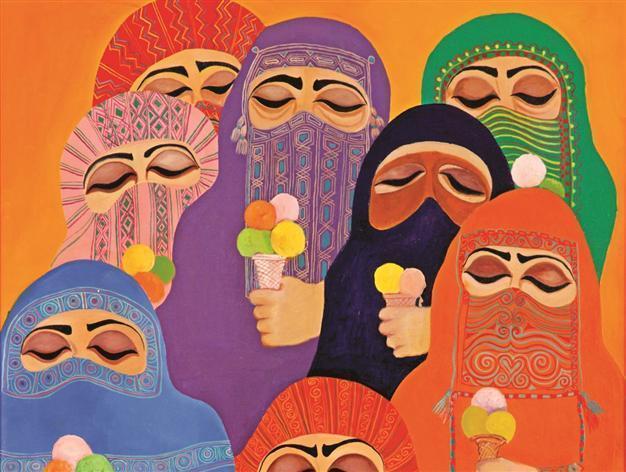Arab art gets star billing in Istanbul
ISTANBUL - Hürriyet Daily News

Works by Fahrelnissa Zeid, Laila Shawa, Rasid, Mustafa Ali, Sabhan Adam, Saliba Douaihy and Muhanna Durra are also on display at Pera Museum.
Art from Jordan is front and center at the Pera Museum for the next two months as the Istanbul art space features works from the Hashemite Kingdom, as well as pieces from the wider region.
Organized in collaboration with the Jordan National Gallery of Fine Arts, the exhibition “Between Desert and Sea, A Selection from the Jordan National Gallery of Fine Arts” consists of modern and contemporary works of various artists from Arab countries around the Mediterranean.
The works of artists from Algeria, Egypt, Jordan, Lebanon, Morocco, Palestine and Tunisia reflect the questions posed by the artists between past and present and between creativity and the real world. The exhibition presents the styles of different generations and the new tendencies in Arab art through paintings, drawings, engravings, ceramics, statues and installations.
The exhibition, which was realized with the support of the Royal Society of Fine Arts’ founder, Princess Wijdan Bint Fawaz al-Hashemi, and curated by the director general of the Jordan National Gallery of Fine Arts, Dr. Khalid Khreis, includes works ranging from painting to drawing, to engraving, ceramics and sculptures. Different generations of artists and diverse styles and trends have all been amassed in the exhibition to give as clear an understanding as possible of contemporary art in the area.
Significant works by Fahrelnissa Zeid, Laila Shawa, Rasid, Mustafa Ali, Sabhan Adam, Saliba Douaihy and Muhanna Durra are also on display at the museum.
Exhibiting works abroad is a tradition for the Jordan National Gallery of Fine Arts; since 1991, the institution has been sending works to different parts of the world.
The institution is under the Royal Society of Fine Arts, which was founded in 1979 and is a cultural, nongovernmental, non-profit organization that created the Jordan National Gallery of Fine Arts in 1980. Since its inauguration, the National Gallery has taken on the task of collecting contemporary works by artists from the Arab and developing worlds in order to be a cultural focal point from which the public can access the artistic output of the region. Its goal is to encourage cultural diversity, disseminate artistic knowledge and promote art from the Islamic and developing worlds. In 1980 it established the contemporary museum collection of artworks from the developing world.
The Jordan National Gallery of Fine Arts is perceived as one of the most important museums in the Middle East, containing in its collection over 3,000 works from Islamic and Arab countries, as well as various countries in Asia, Africa, Europe, Oceania and the Americas. The selection made from the wide collection of the museum – which has taken on the task to be a cultural focal point in its region – aims to present a view into modern and contemporary art in the Arab countries around the Mediterranean.
Collection of the galleryThe collection of the Jordan National Gallery of Fine Arts is internationally recognized. The collection consists of over 2,000 works, including paintings, prints, sculptures, prints, sculptures, photographs, installations, weavings and ceramics by more than 800 artists from 59 countries, mainly in Asia and Africa.
The collection includes works from countries like Algeria, Armenia, Australia, Bahrain, Denmark Egypt, France, Ghana, India, Indonesia, Iran, Iraq, Italy, Japan, Jordan, Kuwait, Kyrgyzstan, Lebanon, Libya, Malaysia, Malta, Mongolia, Morocco, the Netherlands, Nigeria, Oman, Pakistan, Palestine, Papua New Guinea, Peru, Philippines, Qatar, Saudi Arabia, Senegal, Spain, Sudan, Switzerland, Syria, Taiwan, Tajikistan, Thailand, Tunisia, Turkey, Turkmenistan, the United Arab Emirates, the United Kingdom, the United States, Uzbekistan, Yemen and countries in the former Yugoslavia. At the same time, there are also works from the Russian Caucasus republic of Kabardino Balkaria.
The exhibition will continue until April 21.
